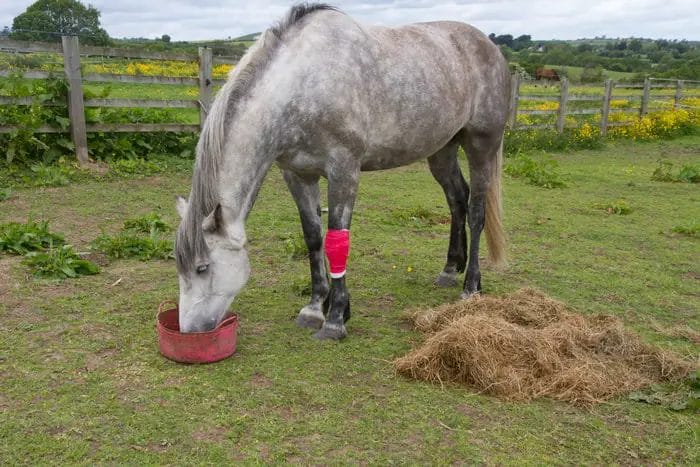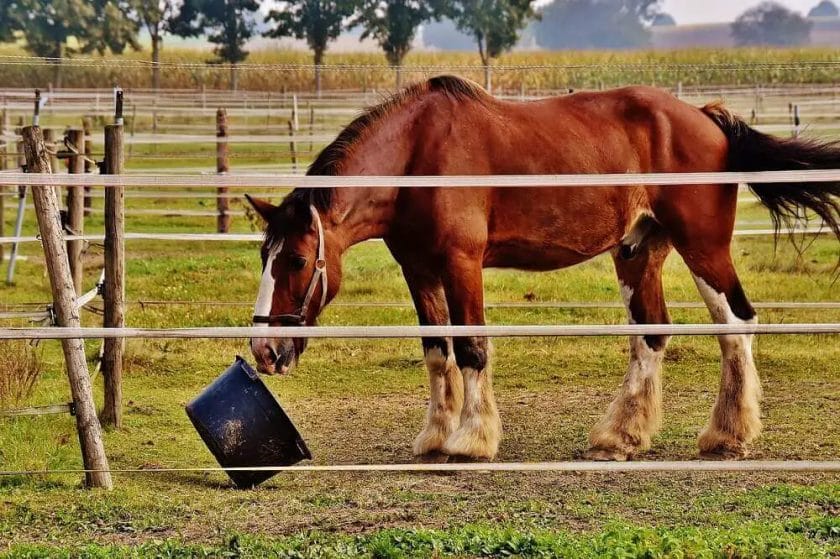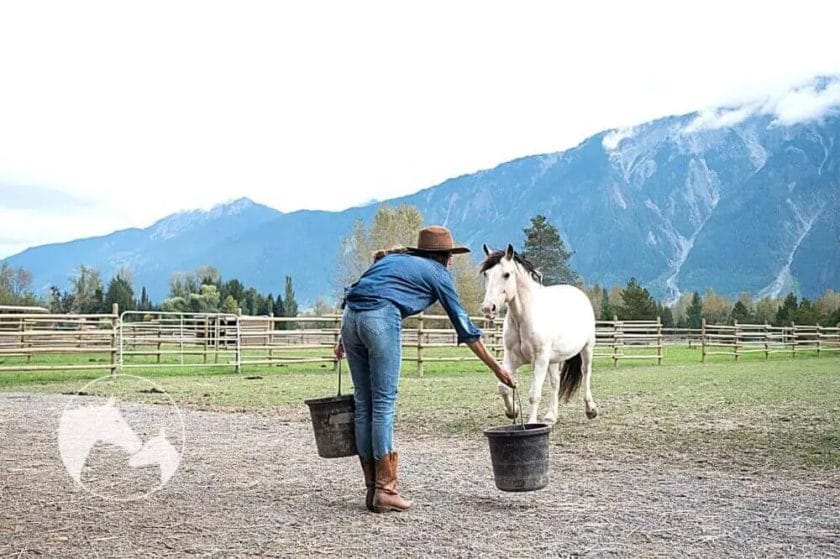Feeding rice bran to horses can provide a multitude of health benefits, but determining the right amount to give them is crucial. The amount of rice bran to feed a horse depends on factors such as the horse’s size, activity level, and overall dietary needs. It is generally recommended to introduce rice bran slowly into the horse’s diet, starting with small amounts and gradually increasing over time. Consulting with a veterinarian or equine nutritionist can help determine the ideal quantity of rice bran to ensure your horse’s health and well-being.

Nutritional Content of Rice Bran for Horses
When it comes to feeding horses, providing them with a balanced diet is essential for their overall health and performance. One ingredient that has gained popularity in equine nutrition is rice bran. Rice bran is the outer layer of the rice grain, which is removed during the milling process. It is rich in nutrients and can be a valuable addition to a horse’s diet.
Rice bran is known for its high fat content, making it an excellent source of energy for horses. It contains both saturated and unsaturated fatty acids, including omega-3 and omega-6 fatty acids. These fatty acids play a crucial role in maintaining the horse’s cardiovascular health and promoting a glossy coat.
In addition to its fat content, rice bran is also a good source of protein, vitamins, and minerals. It contains essential amino acids that are necessary for muscle development and repair. The vitamins present in rice bran include vitamin E, which acts as an antioxidant, protecting the horse’s cells from damage. It also contains B vitamins, which are important for energy metabolism.
Minerals found in rice bran include phosphorus, calcium, and potassium. Phosphorus is vital for bone health, while calcium is necessary for the proper functioning of muscles and nerves. Potassium helps in maintaining fluid balance and promoting proper muscle contractions.
Feeding rice bran to horses can provide several benefits. It can help in weight gain and improve body condition in underweight horses. The high fat content of rice bran makes it an ideal choice for horses that require additional calories without increasing the amount of grain they consume.
Rice bran is also beneficial for horses with certain health conditions. For example, horses with gastric ulcers can benefit from the inclusion of rice bran in their diet. The high fat content forms a protective layer in the stomach, reducing the risk of acid splashing onto the ulcerated areas.
It is important to note that rice bran should be fed in moderation, as excessive amounts can lead to imbalances in the horse’s diet. It is recommended to introduce rice bran gradually and monitor the horse’s weight and overall health. Consulting with a veterinarian or equine nutritionist is advisable to determine the appropriate amount of rice bran to include in a horse’s diet.
In Summary
Rice bran is a nutritious ingredient that can be beneficial for horses. Its high fat content provides a source of energy, while the presence of protein, vitamins, and minerals contributes to overall health and well-being. When fed in moderation, rice bran can help improve body condition, support muscle development, and even aid in managing certain health conditions. As with any dietary changes, it is essential to consult with a professional to ensure a balanced and appropriate diet for your horse.

Recommended Daily Amount of Rice Bran for Horses
Rice bran is a popular equine supplement that offers several benefits for horses. It is a byproduct of the rice milling process and is rich in essential nutrients like fat, protein, and fiber. The high fat content in rice bran makes it an ideal choice for horses that require additional calories in their diet, such as performance horses, senior horses, or horses in need of weight gain.
However, it is important to feed rice bran in moderation and according to your horse’s specific nutritional needs. The recommended daily amount of rice bran for horses may vary depending on factors such as the horse’s weight, activity level, and overall diet. It is always advisable to consult with a veterinarian or equine nutritionist to determine the appropriate amount for your horse.
In general, the recommended daily amount of rice bran for horses is around 0.5 to 1.5 pounds per 1,000 pounds of body weight. This can be divided into multiple smaller feedings throughout the day to ensure optimal digestion and utilization of the nutrients. It is important to introduce rice bran gradually into your horse’s diet to prevent any gastrointestinal upset or digestive disturbances.
When feeding rice bran to horses, it is crucial to consider the overall balance of the diet. Rice bran should not be the sole source of nutrition but rather used as a supplement or added to a well-balanced ration. Horses should have access to good-quality forage, such as hay or pasture, and a complete feed or a mix of grains to meet their overall nutritional requirements.
It is worth noting that the nutritional content of rice bran can vary depending on the processing method and brand. Therefore, it is recommended to choose a reputable brand and check the label for information on fat content, protein content, and any additional ingredients. This will help ensure that you are providing your horse with a high-quality rice bran supplement.
In summary, rice bran can be a valuable addition to a horse’s diet, offering additional calories and essential nutrients. However, it is crucial to feed rice bran in moderation and in conjunction with a well-balanced diet. Consult with a professional to determine the appropriate daily amount of rice bran for your horse based on their specific needs and circumstances.

How to Properly Incorporate Rice Bran into a Horse’s Diet
When it comes to feeding horses, it’s important to provide them with a well-balanced diet that meets their nutritional needs. One popular supplement that is often incorporated into a horse’s diet is rice bran. Rice bran is the outer layer of the rice grain, which is rich in nutrients and can provide numerous benefits to horses. However, it’s essential to know how to properly incorporate rice bran into a horse’s diet to ensure optimal results and prevent any negative impacts on their health.
1. Consult with a Veterinarian or Equine Nutritionist
Before adding rice bran to your horse’s diet, it’s crucial to consult with a veterinarian or an equine nutritionist. They will be able to assess your horse’s specific nutritional needs and provide guidance on the appropriate amount of rice bran to include in their diet. Each horse is unique, and their dietary requirements may vary based on factors such as age, weight, activity level, and overall health.
2. Start with Small Quantities
When introducing rice bran to a horse’s diet, it’s essential to start with small quantities and gradually increase the amount over time. Sudden changes in diet can disrupt a horse’s digestive system and lead to issues such as colic or diarrhea. Begin by adding a small handful of rice bran to their regular feed and monitor their response. If there are no adverse effects, you can gradually increase the amount every few days until reaching the recommended dosage.
3. Choose High-Quality Rice Bran
Not all rice bran products are created equal. It’s crucial to choose a high-quality rice bran that is specifically formulated for horses. Look for products that are stabilized to prevent rancidity and have undergone proper processing to retain maximum nutritional value. Reading product labels and doing research on reputable brands can help ensure you are providing your horse with a quality rice bran supplement.
4. Consider the Fat Content
Rice bran is known for its high-fat content, making it an excellent source of energy for horses. However, it’s important to consider the fat content when determining the appropriate amount to feed your horse. Horses that are prone to weight gain or have certain health conditions may require a low-fat rice bran product or smaller portions. Again, consulting with a professional can help you make an informed decision based on your horse’s individual needs.
5. Monitor Your Horse’s Weight and Condition
After incorporating rice bran into your horse’s diet, closely monitor their weight and condition. Regularly assess whether their body condition is improving, maintaining, or declining. Overfeeding rice bran can lead to weight gain and other health issues, just as underfeeding may not provide the desired benefits. Adjust the quantity of rice bran if necessary, and always consult with a professional if you have any concerns.
6. Evaluate Other Components of the Diet
Rice bran should be viewed as a supplement to a balanced diet rather than a sole source of nutrition. Ensure that your horse’s diet includes a variety of forage, such as hay or pasture, and the appropriate amount of concentrate feed if required. The overall diet should be evaluated to ensure it meets the horse’s nutritional requirements and complements the incorporation of rice bran.
7. Keep Storage and Handling in Mind
Proper storage and handling of rice bran are crucial to maintain its quality and prevent spoilage. Store rice bran in a cool, dry place away from direct sunlight. Seal the package tightly to prevent exposure to air and moisture. If the rice bran becomes rancid or develops an unpleasant smell, it should be discarded. Always check for freshness before feeding it to your horse.
In summary, incorporating rice bran into a horse’s diet can provide several benefits, but it’s essential to do so properly. Seek professional advice, start with small quantities, choose high-quality products, consider the fat content, monitor your horse’s weight and condition, evaluate the overall diet, and ensure proper storage and handling. By following these guidelines, you can incorporate rice bran into your horse’s diet effectively and support their overall health and well-being.
Potential risks or side effects of feeding rice bran to horses
Feeding rice bran to horses is a common practice due to its high fat and fiber content, which can provide additional energy and help with weight gain. However, it is important for horse owners and caretakers to be aware of the potential risks and side effects associated with feeding rice bran to horses. In this section, we will discuss some of the possible risks and side effects that should be considered.
1. Digestive Upset
One of the potential risks of feeding rice bran to horses is digestive upset. Rice bran is high in starch, and horses have a limited ability to digest large amounts of starch in their small intestine. When horses consume excessive amounts of rice bran, it can lead to an imbalance in the gut microflora and result in digestive disturbances such as colic, diarrhea, or gas. It is important to introduce rice bran gradually into a horse’s diet and monitor for any signs of digestive upset.
2. Imbalanced Calcium-Phosphorus Ratio
Rice bran is naturally low in calcium and high in phosphorus, which can disrupt the balance of these minerals in a horse’s diet. An imbalanced calcium-phosphorus ratio can lead to skeletal disorders such as developmental orthopedic disease (DOD) in young horses or metabolic imbalances in adult horses. To mitigate this risk, it is essential to ensure that the horse’s overall diet is properly balanced with appropriate levels of calcium and phosphorus.
3. Allergic Reactions
Although rare, some horses may develop allergic reactions to rice bran or specific components within it. Allergic reactions can manifest as skin rashes, hives, itching, or respiratory difficulties. If a horse shows any signs of an allergic reaction after consuming rice bran, it is crucial to discontinue its use immediately and consult with a veterinarian.
4. Increased Caloric Intake
Rice bran is a concentrated source of calories, and excessive consumption can lead to weight gain or obesity, especially in horses that have low activity levels or are prone to metabolic disorders such as equine metabolic syndrome (EMS) or insulin resistance. It is essential to consider the horse’s individual metabolic needs and adjust the feeding amount of rice bran accordingly to maintain a healthy body condition.
5. Contamination or Spoilage
Rice bran is susceptible to contamination by molds, bacteria, or other pathogens if not stored properly or if the bran itself is of poor quality. Contaminated or spoiled rice bran can pose health risks to horses and may lead to gastrointestinal issues or other health problems. It is crucial to purchase rice bran from reputable sources and store it in a cool, dry place to maintain its freshness and prevent contamination.
In summary, while feeding rice bran can offer several benefits to horses, it is essential to be aware of the potential risks and side effects associated with its use. It is recommended to consult with a veterinarian or equine nutritionist to develop an appropriate feeding plan that considers the horse’s specific needs, overall diet, and any pre-existing health conditions. By being mindful of these risks and taking appropriate precautions, horse owners can safely incorporate rice bran into their horse’s diet.
FAQs
1. How much rice bran should I feed my horse?
The amount of rice bran to feed a horse depends on its weight and individual needs. As a general guideline, you can start with 0.5 to 1 pound of rice bran per day for a 1,000-pound horse. However, it’s best to consult with a veterinarian or equine nutritionist to determine the precise amount for your horse.
2. Can rice bran be a complete feed for horses?
No, rice bran alone is not a complete feed for horses. While it is a good source of fat and some nutrients, horses require a balanced diet that includes forage (hay or pasture) and additional protein, vitamins, and minerals. Rice bran can be used as a supplement or part of a well-balanced ration, but it should not be the sole source of nutrition.
3. Are there any risks associated with feeding rice bran to horses?
Rice bran is generally safe for horses when fed in appropriate quantities. However, it is high in phosphorus and can disrupt the calcium-to-phosphorus ratio in a horse’s diet if fed in excess. It’s important to monitor the overall nutrient balance in your horse’s diet and adjust the amount of rice bran accordingly. If you have any concerns, consult with a veterinarian or equine nutritionist.
Conclusion:
In conclusion, determining the right amount of rice bran to feed a horse is crucial for its overall health and well-being. While there is no one-size-fits-all answer, it is recommended to consult with a veterinarian or equine nutritionist to assess the specific needs of your horse. Gradually introducing rice bran into their diet and monitoring their response is essential to avoid digestive issues. Remember that the amount of rice bran will depend on factors such as the horse’s age, weight, activity level, and existing dietary requirements. Regularly adjusting the quantity of rice bran and observing any changes in your horse’s condition will ensure optimal nutrition and performance.
